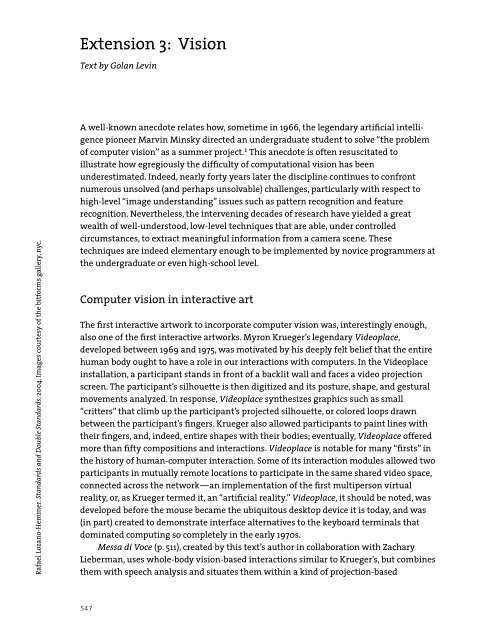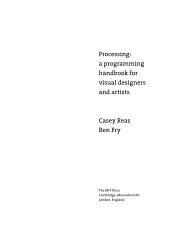Fractal.Invaders, Substrate (Interview with Jared Tarbell) - Processing
Fractal.Invaders, Substrate (Interview with Jared Tarbell) - Processing
Fractal.Invaders, Substrate (Interview with Jared Tarbell) - Processing
You also want an ePaper? Increase the reach of your titles
YUMPU automatically turns print PDFs into web optimized ePapers that Google loves.
Rafael Lozano-Hemmer. Standards and Double Standards, 2004. Images courtesy of the bitforms gallery, nyc.<br />
Extension 3: Vision<br />
Text by Golan Levin<br />
A well-known anecdote relates how, sometime in 1966, the legendary artifi cial intelligence<br />
pioneer Marvin Minsky directed an undergraduate student to solve “the problem<br />
of computer vision” as a summer project. 1 This anecdote is often resuscitated to<br />
illustrate how egregiously the diffi culty of computational vision has been<br />
underestimated. Indeed, nearly forty years later the discipline continues to confront<br />
numerous unsolved (and perhaps unsolvable) challenges, particularly <strong>with</strong> respect to<br />
high-level “image understanding” issues such as pattern recognition and feature<br />
recognition. Nevertheless, the intervening decades of research have yielded a great<br />
wealth of well-understood, low-level techniques that are able, under controlled<br />
circumstances, to extract meaningful information from a camera scene. These<br />
techniques are indeed elementary enough to be implemented by novice programmers at<br />
the undergraduate or even high-school level.<br />
Computer vision in interactive art<br />
The fi rst interactive artwork to incorporate computer vision was, interestingly enough,<br />
also one of the fi rst interactive artworks. Myron Krueger’s legendary Videoplace,<br />
developed between 1969 and 1975, was motivated by his deeply felt belief that the entire<br />
human body ought to have a role in our interactions <strong>with</strong> computers. In the Videoplace<br />
installation, a participant stands in front of a backlit wall and faces a video projection<br />
screen. The participant’s silhouette is then digitized and its posture, shape, and gestural<br />
movements analyzed. In response, Videoplace synthesizes graphics such as small<br />
“critters” that climb up the participant’s projected silhouette, or colored loops drawn<br />
between the participant’s fi ngers. Krueger also allowed participants to paint lines <strong>with</strong><br />
their fi ngers, and, indeed, entire shapes <strong>with</strong> their bodies; eventually, Videoplace offered<br />
more than fi fty compositions and interactions. Videoplace is notable for many “fi rsts” in<br />
the history of human-computer interaction. Some of its interaction modules allowed two<br />
participants in mutually remote locations to participate in the same shared video space,<br />
connected across the network—an implementation of the fi rst multiperson virtual<br />
reality, or, as Krueger termed it, an “artifi cial reality.” Videoplace, it should be noted, was<br />
developed before the mouse became the ubiquitous desktop device it is today, and was<br />
(in part) created to demonstrate interface alternatives to the keyboard terminals that<br />
dominated computing so completely in the early 1970s.<br />
Messa di Voce (p. 511), created by this text’s author in collaboration <strong>with</strong> Zachary<br />
Lieberman, uses whole-body vision-based interactions similar to Krueger’s, but combines<br />
them <strong>with</strong> speech analysis and situates them <strong>with</strong>in a kind of projection-based<br />
547



